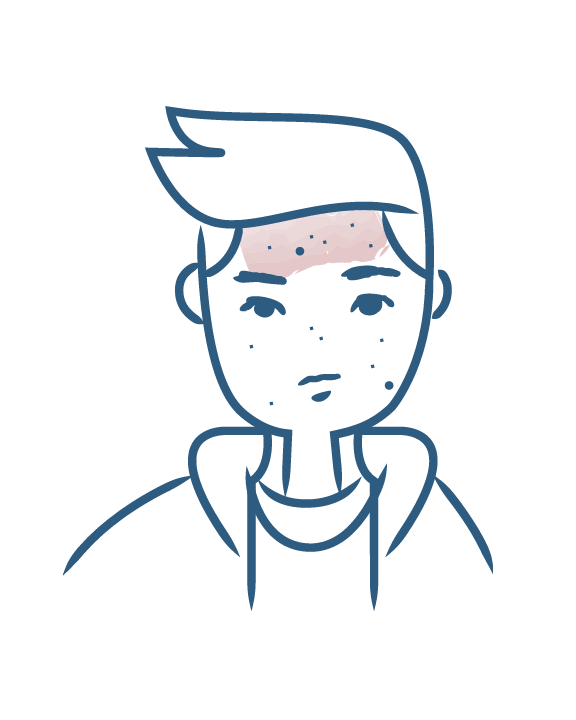
What are the different types of acne?
Acne is a widespread skin condition that mainly affects teenagers. It doesn’t only affect teenagers, however! There are many different forms of acne and it can affect anyone, at any age, with varying degrees of severity and varying degrees of visibility on the face, back or chest. Knowing your acne type is key to understanding the treatment prescribed by your doctor and/or the cosmetics and dermo-cosmetics products recommended by your pharmacist.
“Juvenile acne, a real pain!”
Juvenile acne is teen (12-17 years old) and pre-teen (9-11 years old) acne and is the most common form of the condition. About 80% of young people are affected by this type of acne. Skin becomes oily and shiny, and spots such as blackheads, whiteheads and red spots appear. Juvenile acne develops over several months or years and requires daily care, particularly to reduce the risk of scarring in adulthood.
"I suffer from retentional acne."
Retentional or comedonal acne is often the first stage of acne. It is marked by the presence of blackheads (open comedones) and whiteheads (closed comedones or microcysts). Comedones are very small lesions, varying in number and giving the skin a "dirty" appearance, especially if skin is oily and pores are dilated. Keratolytic active ingredients contained in medicinal and/or dermo-cosmetic treatments help to unclog pores and act effectively on this acne type.
"My acne is inflammatory"
Inflammatory acne is probably the best-known acne type. Inflammatory acne spots appear directly or in the form of comedones (blackheads or whiteheads), due to the activity of a skin bacteria known as Cutibacterium acnes. Spots are red, of varying sizes, depth and degrees of painfulness. A distinction is made between papules (small red spots), pustules (papules with a white tip) and nodules (large red spots more than 5 mm in diameter). Acne flare-ups often combine retentional acne and inflammatory acne, hence the value of a comprehensive treatment whose active ingredients attack both retentional and inflammatory lesions.
"I have nodular acne."
Nodular acne is also called nodulocystic acne or acne conglobata. It is a rare but serious form of chronic acne, characterized by numerous retentional and inflammatory lesions, particularly nodules. It is treated using oral isotretinoin, which is effective but can dry out the skin, so dermo-cosmetic compensatory skin care should be used for comfort.
"I was hospitalized with acne fulminans."
Acne fulminans is a form of acute acne, marked by dramatic and striking damage to the face and torso, but also by non-cutaneous signs such as fever or joint pain. Hospitalization is necessary to treat patients quickly.
"My son suffers from severe acne."
Approximately 15% of people with acne suffer from a severe form of the disease. Severe acne means the whole face is affected, with a mixture of blackheads, whiteheads and red spots of varying sizes. Other parts of the body can also be affected, such as the back. Severe acne tends to have a major impact on quality of life and can disrupt people's relationships with others. Seeing a doctor enables effective treatment such as oral isotretinoin.
"My teenage years are over, and I still have acne and marks on my face!”
Adult acne is common, especially in women aged 25 and over. Acne in women tends to occur on the lower part of the face, while acne in men tends to appear on the back but can also affect the face. This acne type is difficult to live with, whether at work, around friends or even in the privacy of your own home. But don't despair - there are solutions!
"My baby has acne."
Infant acne affects babies between 0 and 3 months of age. Don't be alarmed if your baby has acne spots. This acne type is very common and usually disappears after a few weeks or months. No specific treatment is required beyond a few basic tips: wash the skin gently, thoroughly dry it, do not apply oily cosmetics, and monitor developments.
Our care routines
Oily or acne-prone skin
- Discover Anti-blemish face care summer routine for adult skin
Anti-blemish face care summer routine for adult skin
Dermatological expertise
To better understand your skin and hair, discover our exclusive content and innovative care products designed to improve your quality of life..

